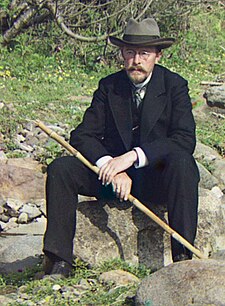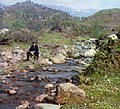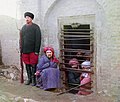Sergey Prokudin-Gorsky
From Wikipedia, the free encyclopedia
| Sergey Prokudin-Gorsky | |
 Sergey Prokudin-Gorsky. Self portrait on the Korolistskali River, 1915
|
|
| Born | August 31, 1863 Murom, Russian Empire |
|---|---|
| Died | September 27, 1944 (aged 81) Paris, France |
| Resting place | Sainte-Geneviève-des-Bois Russian Cemetery |
| Nationality | Russian |
| Known for | Early techniques for taking colour photographs |
Sergey Mikhaylovich Prokudin-Gorsky (Russian: Серге́й Миха́йлович Проку́дин-Го́рский, August 31 [O.S. August 19] 1863, Murom, Russian Empire – September 27, 1944, Paris, France) was a Russian chemist and photographer. He is best known for his pioneer work in colour photography of early 20th century Russia.[1]
Contents |
[edit] Biography
Prokudin-Gorsky was born in Murom in what is now Vladimir Oblast. His parents were of Russian nobility, and the family had a long military history.[2] They soon moved to Saint Petersburg, where Prokudin-Gorsky enrolled in Saint Petersburg State Institute of Technology to study chemistry under Dmitri Mendeleev. He also studied music and painting at the Imperial Academy of Arts. In 1889 he traveled to Berlin to continue his studies in photochemistry at the Technical University of Berlin with Adolf Miethe,[3] who was working on colour dyes and three-colour photography.[4]
In 1890, Prokudin-Gorsky married Anna Aleksandrovna Lavrov and later the couple had sons Michel and Dimitri and daughter Ekaterina.[5] Lavrov was the daughter of the Russian industrialist Alexander Stepanovich Lavrov, who among others was an active member in the Imperial Russian Technical Society (IRTS).[5] Prokudin-Gorsky subsequently became the director of the executive board of Lavrov's metal works near Saint Petersburg, and continued in the position until the October Revolution. He also joined Russia's oldest photographic society, the photography section of the IRTS, presenting papers and lecturing on the science of photography.[4] In 1901 he established a photography studio and laboratory in Saint Petersburg and further developed Miethe's methods on colour photography. Throughout the years his photographic work, publications and slideshows to other scientists and photographers in Russia, Germany and France earned him praise,[5] and in 1906 he was elected the president of the IRTS photography section and editor of Russia's main photography journal, the Fotograf-Liubitel.[4]
Prokudin-Gorsky's perhaps best known work from the time is the only colour portrait of Leo Tolstoy,[6] which was then reproduced in various publications and printed for framing and on postcards.[5][7] The fame from this photo and his earlier photos of Russia's nature and monuments earned him invites to show his work to the Grand Duke Michael Alexandrovich of Russia, Empress Maria Feodorovna, and eventually the tsar Nicholas II of Russia and his family in 1909.[4] The czar enjoyed the demonstration, and now with his blessing, Prokudin-Gorsky got the permission and funding to document Russia in colour.[8] In the course of 10 years, he was to make a collection of 10,000 photos.[9] Prokudin-Gorsky considered the project his life's work[5] and continued his photojourneys through Russia until after the October Revolution. He was appointed a new professorship under the new rule, but he soon left the country in August 1918.[10] He still pursued scientific work in colour photography, published papers in English photography journals and together with his colleague S.O. Maksimovich got patents in Germany, England, France and Italy.[5]
In 1920 Prokudin-Gorsky remarried and had a daughter with his assistant Maria Fedorovona née Schedrimo. The family finally settled in Paris in 1922, reuniting with his first wife and children.[4] Prokudin-Gorsky set up a photo studio there together with his three adult children, naming it after his fourth child Elka. In the 1930s the elderly Prokudin-Gorsky continued with lectures showing his photos of Russia to the Russian youth in France, but stopped commercial work and left the studio to his children, who named it Gorsky Frères. He died on September 27, 1944 and is buried in the Sainte-Geneviève-des-Bois Russian Cemetery.[5]
[edit] Photography technique
His own research yielded patents for producing colour film slides and for projecting colour motion pictures. His process used a camera that took a series of three monochrome pictures in sequence, each through a different coloured filter. By projecting all three monochrome pictures using correctly-coloured light, it was possible to reconstruct the original colour scene. Any stray movement within the camera's field of view showed up in the prints as multiple "ghosted" images, since the red, green and blue images were taken of the subject at slightly different times.
The exposure time of the frames is likely to have varied, even if the developed negatives were later on similar glass plates. In a letter to Leo Tolstoy requesting a photo session, Prokudin-Gorsky described each photo taking one to three seconds, but when recollecting his time with Tolstoy, he described a six second exposure on a sunny day.[11][7] Blaise Agüera y Arcas estimated the exposure of a 1909 photo taken in broad daylight to have had combined exposures of over a minute, using the movement of the moon as comparison.[12]
Though colour prints of the photos were difficult to make at the time and slideshow lectures consumed much of the time he used to demonstrate his work, his studio worked in publishing prints of the photos in journals, books, postcards and large photogravures.[4] Many of the original prints from his publishing studio have survived to this day.[13]
[edit] Documentary of the Russian Empire
Around 1905, Prokudin-Gorsky envisioned and formulated a plan to use the emerging technological advancements that had been made in colour photography to systematically document the Russian Empire. Through such an ambitious project, his ultimate goal was to educate the schoolchildren of Russia with his "optical colour projections" of the vast and diverse history, culture, and modernization of the empire.[14]
Outfitted with a specially equipped railroad car darkroom provided by Tsar Nicholas II, and in possession of two permits that granted him access to restricted areas and cooperation from the empire's bureaucracy, Prokudin-Gorsky documented the Russian Empire around 1909 through 1915. He conducted many illustrated lectures of his work. His photographs offer a vivid portrait of a lost world—the Russian Empire on the eve of World War I and the coming Russian Revolution. His subjects ranged from the medieval churches and monasteries of old Russia, to the railroads and factories of an emerging industrial power, to the daily life and work of Russia's diverse population.
It has been estimated from Prokudin-Gorsky's personal inventory that before leaving Russia, he had approximately 3500 negatives.[15] Upon leaving the country and exporting all his photographic material, about half of the photos were confiscated by Russian authorities for containing material that was strategically sensitive for war-time Russia.[4] According to Prokudin-Gorsky's notes, the photos left behind were not of interest to the general public.[15] Some of Prokudin-Gorskii's negatives were given away,[16] some he hid on his departure.[17]. Outside the Library of Congress collection, none have yet been found.[15]
By Prokudin-Gorsky's death, the tsar and his family had long since been executed during the Russian Revolution, and the Communist rule had been established over what was once the Russian Empire. The surviving boxes of photo albums and fragile glass plates the negatives were recorded on were finally stored in the basement of a Parisian apartment building, and the family was worried of them getting damaged. The United States Library of Congress purchased the material from Prokudin-Gorsky's heirs in 1948 for $3500–$5000 on the initiative of a researcher enquiring their whereabouts.[15] The Library counted 1902 negatives and 710 album prints without corresponding negatives in the collection.[18]
Due to the difficulty in reproducing prints of sufficient quality from the negatives, only some hundred were used for exhibits, books and scholarly articles after the Library of Congress acquired them.[4] The best known is perhaps the 1980 coffee table book Photographs for the Tsar: The Pioneering Color Photography of Sergei Mikhailovich Prokudin-Gorskii Commissioned by Tsar Nicholas II[19], where the photos were combined from black & white prints of the negatives.[20] It was only with the advent of digital image processing that multiple images could be satisfactorily combined into one.[21] The Library of Congress undertook a project in 2000 to make digital scans of all the photographic material received from Prokudin-Gorsky's heirs, and contracted with the photographer Walter Frankhauser to combine the monochrome negatives into colour images.[22] He created 122 color renderings using a method he called digichromatography, and commented that each image took him around six to seven hours to align, clean and colour correct.[23] In 2001, the Library of Congress produced an exhibition from these renderings, The Empire That Was Russia: The Prokudin-Gorskii Photographic Record Recreated.[24] The photographs have since been the subject of many other exhibitions in the area where Prokudin-Gorsky took his photos.[25][26][27][28][29][30]
In 2004, the Library contracted with computer scientist Blaise Agüera y Arcas to produce an automated colour composite of each of the 1902 negatives from the high resolution digital images of the glass plate negatives. He applied algorithms to compensate for the differences between the exposures, and prepared colour composites of all the negatives in the collection.[12] As the Library of Congress offers the high resolution images of the negatives freely on the internet, many others have since created their own colour representations of the photos,[31] and they have become a favourite testbed for computer scientists.[32] 100 years after Prokudin-Gorsky explained his ambitions to the tsar, people all around the world are finally able to view his work, fulfilling his goal of everyone seeing the past glory of the Russian Empire.
[edit] Gallery
|
Monastery of St. Nilus on Stolbny Island in Lake Seliger near Ostashkov, ca. 1910 |
Early colour photograph as part of Sergey's work to document the Russian Empire from 1909 to 1915 |
||
|
Kama river near Perm (1910) |
|||
[edit] See also
- Albert Kahn, a patron of photography, who funded photographers to travel around the world recording colour images and cine film of diverse ethnic societies between 1909 and 1931.
[edit] References
- ^ Photographer to the Tsar: Sergei Mikhailovich Prokudin-Gorskii. Library of Congress. Retrieved 13 August 2006
- ^ Tatarnikova, Annette (2006-06-16). Tsarskiy fotograf. (Russian)
- ^ "Rossiya, kotorooyoo mi zabili: Tsvyetnaya fotolyetopis' Rossiyskoy impyerii." Mir stroityel'stva, Iz istorii Moskvi. October 2007 (Russian)
- ^ a b c d e f g h Adamson, Jeremy; Zinkham, Helena (2002). "The Prokudin-Gorskii Legacy: Color Photographs of the Russian Empire, 1905-1915" (pdf). Comma (International Council on Archives) 3-4 (Archives and Archival Issues of Russia): 107-143. ISSN 3-598-01357-4. http://www.ica.org/en/node/30480.
- ^ a b c d e f g Garanina, Svetlana (2003). "Sergei Mikhailovich Prokudin-Gorsky Biography". http://www.prokudin-gorsky.ru/download/Prokudin-Gorsky%20Biography.pdf.
- ^ Kington, Miles (2001-09-25). What's the Russian for 'say cheese'? The Independent
- ^ a b Prokudin-Gorsky's Color Photographs of Tolstoy. Tolstoy Studies Journal, University of Toronto.
- ^ Dikovitskaya, Margaret. 2007. "Central Asia in Early Photographs: Russian Colonial Attitudes and Visual Culture." Slavic Eurasian Studies No. 14: Empire, Islam, and Politics in Central Eurasia. Hokkaido: Slavic Research Center
- ^ Garanina, SP. 1999. "Dyelo Kantsyelyarii Sovyeta Ministrov o priobryetyenii v kaznoo kollyektsii fotografichyeskih snimkov dostoprimyechatyel'nostyey Rossii S. M. Prokoodina-Gorskogo, 1910—1912 gg." Fundamental Digital Library of Russian Literature and Folklore (Russian)
- ^ Interview with Orlando Figes, presenter of a BBC documentary about Gorsky. BBC Four.
- ^ Garanina, S. 1970. "L.N.Tolstoy na tsvyetnom foto". Nauka i Zhizn. (Russian)
- ^ a b Blaise Agüera y Arcas (2004-09-28). Reconstructing Prokudin-Gorskii's Color Photography in Software. Library of Congress.
- ^ Spisok 416: naslyediye S. M. Prokoodina-Gorskogo. Hrami Rossii (Russian)
- ^ Dennis, Nadia. Tsvyeta ooshyedshyego mira. (Russian)
- ^ a b c d Minachin, Victor (2003). "The Splendors of Russia Collection" in the Library of Congress. "Restavrator-M" Restoration Center.
- ^ Kostinsky, Alexander. (2005-01-11) Rossiya nachala XX vyeka v fotografiyah Syergyeya Prokoodina-Gorskogo i tsifroviye tyehnologii. Radio Svoboda (Russian)
- ^ Muir, Robin (2001-06-24). "By appointment to the tsar". The Independent on Sunday: p. 24-25. "Tantalisingly, he hid a dozen or so colour plates of the Romanovs but never disclosed where (most likely in St Petersburg) They may yet surface."
- ^ Robb, Andrew. May 2001. "Albums, Photos, Glass Plate Negatives." Conservation Corner - Library of Congress Information Bulletin, May 2001 - Vol 60, No. 5.
- ^ Allshouse, Robert H., ed (1980). Photographs for the Tsar: The Pioneering Color Photography of Sergei Mikhailovich Prokudin-Gorskii Commissioned by Tsar Nicholas II. London: Sidgwick & Jackson. ISBN 0283986786.
- ^ Goldsmith, Arthur (1980). In Photographs for the Tsar. London: Sidgwick & Jackson.
- ^ Hubička, Jan (2008). Modern reproductions of photographs by Prokudin-Gorskij
- ^ Digitizing the Collection. Library of Congress Prints & Photographs Online Catalog - Prokudin-Gorskii Collection
- ^ Austen, Ian. (2001-06-14). Colors of a Lost Empire Are Reborn, Digitally. The New York Times.
- ^ All Exhibitions at the Library of Congress
- ^ Library of Congress Exhibition of Russian Photographs Opens in St. Petersburg on April 12, 2003. Library of Congress.
- ^ Osipov, Georgy (2003). Miracles of the Tsar's Photographer. The New Times.
- ^ Teterin, Igor (2005-06-03). Kakoy ti bila, Rossiya!. Pärnu Express. (Russian)
- ^ Rossiya: vzglyad chyeryez stolyetiye. Pärnu Express, 28.04.2006. (Russian)
- ^ Sergei Mikhailovich Prokudin-Gorsky. A Selection from the Collection “The Splendors of Russia in Natural Color”—Color Photographs from the Years 1905–1916. Šechtl & Voseček Museum of Photography, 2006.
- ^ Exhibition of Sergei Prokudin-Gorskii’s at TBC Bank Places History in Full Color. U.S. Embassy Georgia, January 18, 2007.
- ^ Color Photography Method. Library of Congress Prints & Photographs Online Catalog - Prokudin-Gorskii Collection
- ^ Girvan, Ray (2005). The colour of the past. Scientific Computing World, July/August 2005.
[edit] External links
| Wikimedia Commons has media related to: Sergei Mikhailovich Prokudin-Gorskii |
- The Empire That Was Russia: The Prokudin-Gorskii Photographic Record Recreated – Library of Congress exhibit]
- Prokudin-Gorskii site at the Museums of Russia – Federal Agency on Press and Mass Communications
- Russian database with all the Prokudin-Gorskii photos, including those not yet restored












